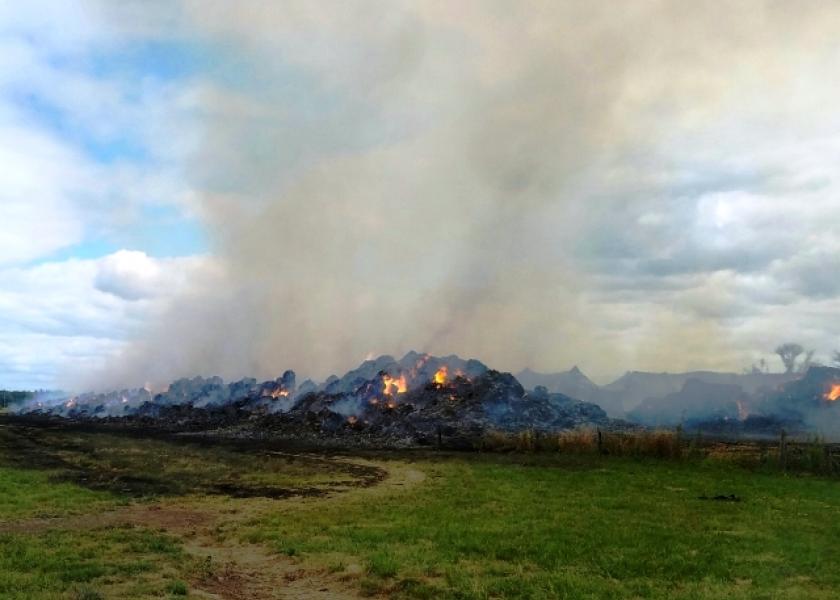Hay and Straw Barn Fires a Real Danger

We’ve heard of one barn fire here in Ohio this week and a lot of hay was put up June 22 ahead of the rain. Much of the hay was wetter than it should have been for safe dry hay storage. Watch those moist bales very carefully for the next two to three weeks. Use a hay temperature probe and monitor the internal temperature of the hay during these first three weeks after baling.
Usually, we think of water and moisture as a way to put a fire out, but the opposite is true with hay and straw, which when too wet can heat and spontaneously combust. This is more common with hay than straw because there is more plant cell respiration in hay. When baled at moistures over 20% mesophilic bacteria release heat causing temperatures to rise between 130⁰F and 140⁰F. If bacteria die and bales cool, you are in the clear but if thermophilic bacteria take over temperatures can raise to over 175⁰F.
The moist bales should be kept outside or in a well ventilated area. Don’t stack the moist bales, because that prevents the heat and moisture left in the hay from escaping. It is normal for hay to go through a “sweat” in the first few days after baling. Internal temperatures of 110° F in the first five days after baling are quite common in our region and are not a big concern.
Assessing the Fire Risk
- Most hay fires occur within the first six weeks after baling
- Was the field evenly dry or did it have wet spots
- Were moistures levels kept at 20% or less
- If over 20% was hay preservative used
Monitoring at-risk Hay
If you are concerned that your hay or straw may be a fire risk, you should monitor it twice a day for the first six weeks or until low temperatures stabilize. Ideally, temperatures are taken from the center of the stack or down about 8 feet in large stacks.
If you have a long probe thermometer it can be used but some homemade options are available. A ¾ inch pipe with the ends closed into a point and 3/16 inch holes drilled in the bottom 4 inches can work well, lower a thermometer on a string or the sensor wire of a thermometer into the pipe. The sensor on a long wire can work very well once in place you can read temperatures without removing it. Leave the thermometer in the stack for 15 minutes to get an accurate reading.
Another cruder option is to stick a 3/8 pipe into the stack and pull out twice a day if the pipe is too hot to hold in your hand, you are at risk for a fire. Be very cautious when taking hay temperatures if the hay gets hot and a cavity burns out underneath you can fall in. Use planks to spread out your weight and have someone nearby in case you fall in a burned out pocket. Using a harness and tying yourself off would be even better as a safety measure when checking bales.
Hay bale temperatures of 120° to 130° F will likely result in mold growth and will make the protein in the hay less available to animals. While those temperatures are not high enough to cause hay fires, the concern is if the mold growth continues and pushes temperatures upward into the danger zone.
If the temperature in the hay continues to rise, reaching temperatures of 160° to 170° F, then there is cause for alarm. At those elevated temperatures, other chemical reactions begin to occur that elevate the temperature much higher, resulting in spontaneous combustion of the hay in a relatively short period of time. If the hay temperature is 175° F or higher, call the fire department immediately, because fire is imminent or present in the stack.
Critical Temperatures and Actions to Take
Temperatures (⁰F) Condition and Action
125° No Action Needed
150° Hay is entering the danger zone. Check twice daily. Disassemble stacked hay bales to promote air circulation to cool the hay outside.
160° Hay has reached the danger zone. Check hay temperature every couple of hours. Disassemble stacked hay to promote air circulation to cool hay have fire department present while unstacking from here on.
175° Hot pockets are likely. Alert fire service to possible hay fire incident. Close barns tightly to eliminate oxygen
190° With the assistance of the fire service, remove hot hay. Be aware the bales may burst into flames keep tractors wet
200° + With the assistance of the fire service, remove hot hay. Most likely, a fire will occur. Keep tractors wet and fire hose lines charged in the barn and along the route of where bales are to be stacked.
Extreme caution needs to be taken when monitoring hot hay. Please read the article below for additional safety guidelines and procedures for monitoring hot bales and for preventing and controlling hay fires:If you are in the risk zone and there is machinery or livestock also in the barn, remove them before removing the hay for safety. Also call the fire department when you are in the risk range. They would much rather be present and not have to put a fire out them have to call mutual aid when your entire barn is on fire. For more information on Preventing Fires in Baled have and straw visit- http://articles.extension.org/pages/66577/preventing-fires-in-baled-hay-and-straw
Hay Fire Prevention and Control, Virginia Cooperative Extension http://www.pubs.ext.vt.edu/442/442-105/442-105.html







